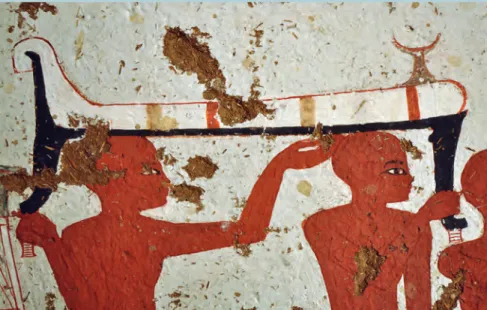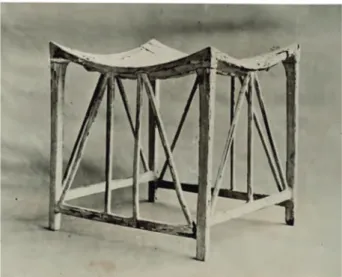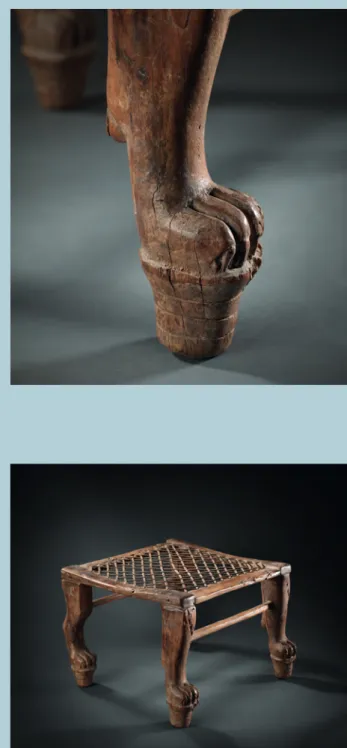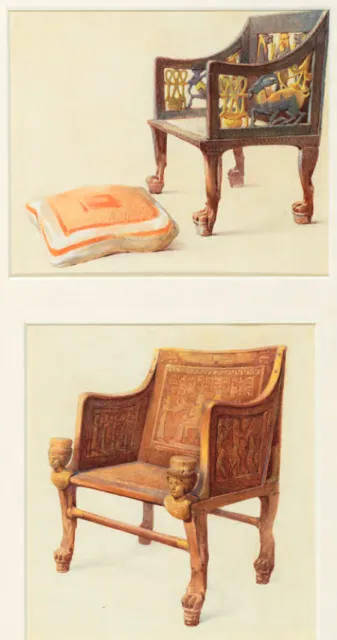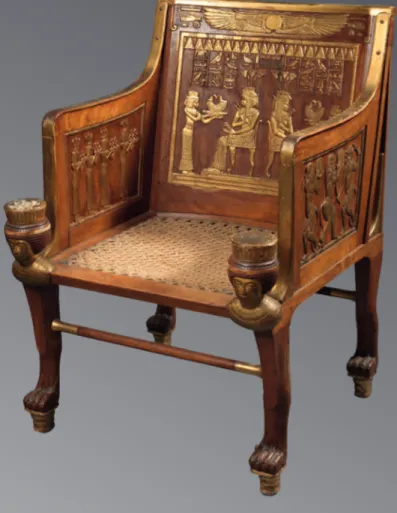Collection Aegyptiaca Leodiensia 12
TUTANKHAMUN
DISCOVERING THE FORGOTTEN PHARAOH
Catalogue edited by
Simon Connor and Dimitri Laboury
Exhibition organized at the Europa Expo space
TGV train station “Les Guillemins”
Liège, 14th December 2019 – 30th August 2020
Presses Universitaires de Liège
2020
The exhibition “Tutankhamun. Discovering the
Forgotten Pharaoh” was produced by the scrl-fs Europa Expo and realised by the non-profit organisation Collections & Patrimoines.
Commissioner: René Schyns
Curators: Dimitri Laboury and Simon Connor Managing Director: Alain Mager
Operational and financial management: Marie Kupper Technical Director: Agostinho da Cunha
Human Resources Department and ticketing: Rosabella
Sanchez
Scientific Committee: Jean-Michel Bruffaerts, Simon
Connor, Alisée Devillers, Pierre Hallot, Dimitri Laboury, Hugues Tavier, Claudia Venier
Conception: Dimitri Laboury, Simon Connor, Alix
Nyssen, Guy Lemaire, René Schyns
Artistic direction: Christian Merland, Sophie Meurisse,
Geneviève Schyns
Direction of the reconstitution of pharaonic sets: Hugues
Tavier
Communication: CARACASCOM.com, Manfred
Dahmen, Lionel Halleux
Attaché of direction: Youri Martin Computer graphics: Michael Van Raek
Texts, legends and audio guides: Eddy Przybylski Shelf Coordinator: Laurent Dillien
Workshop manager: Julien Sevenants
Set designers: Ahmed Hassan, Maurice Lai, Joëlle
Luremonde, David Hermans, Maïti Simon, Daniel Voisin, Philippe Weerts
Lights: Carlo Casuccio, Renaud Lavigne
Carpenters: Stefano Azzalin and Benjamin Bouillot Fitters: Mike Tambour, Pascal Norga, Nicolas Detrooz,
Alain Parmentier.
Ironwork: Pierre Leboulange Sound engineer: Serge Winandy Technicians: e.m.c. Filippo Pultrone
Translation of texts in the exhibition: Vanessa Davies,
Maud Slingenberg; colingua
Audio guides: rsf/trillenium
EUROPA EXPO scrl-fs
President: Karl-Heinz Lambertz
Administrators: Anne Faway-Reul, Marie Kupper,
Laurence Schyns and René Schyns
Managing Director: Alain Mager
COLLECTIONS & PATRIMOINES asbl
President: René Schyns
Administrators: Claude Dedye, Charlotte Ferrara, Michel
Konen, Guy Lemaire, Christian Merland and Jean-Claude Phlypo
Managing Director: Alain Mager
LENDING INSTITUTIONS
Germany
– Hildesheim, Roemer- und Pelizaeus-Museum – Karlsruhe, Badisches Landesmuseum – Baden State
Museum
– Tübingen, Ägyptische Sammlung der Eberhard Karls Universität Tübingen
England
– Cambridge, Fitzwilliam Museum
– Manchester, Manchester Museum – University of Manchester
– Private collectors
Belgium
– Brussels, Royal Museums of Art and History – Brussels, royal palace
– Morlanwez, Musée Royal de Mariemont – Private collectors
Canada
– Toronto, Bata Shoe Museum
Spain
– Private collector
France
– Paris, Musée du Louvre
– Strasbourg, Institut d’Égyptologie de l’Université de Strasbourg
– Private collector
Netherlands
– Leiden, Rijksmuseum van Oudheden
Acknowledgements
Jean-Lou Stefan
The anonymous private collectors who entrusted us with their pieces.
This book is dedicated to the memory of Agostinho da Cunha, untimely seized by the Abductor, as ancient Egyptians called it.
The Exhibition ...15
Tutankhamun. Discovering the Forgotten Pharaoh [Simon CONNOR, Dimitri LABOURY, Alain MAGER and René SCHYNS] ... 16
Behind the Scenes: How to Set up an Exhibition [Alix NYSSEN]... 22
Replicas on Display [Simon CONNOR and Eid MERTAH] ... 24
The Carter Adventure ...31
The Discovery of Tutankhamun’s Tomb [Dimitri LABOURY] ... 32
Carter’s Palette [Hugues TAVIER] ... 38
Tutankhamun’s Tomb: The Exception or the Rule? [Dimitri LABOURY] ... 42
Reconstructing the Tomb: Copying as a Method of Technical and Scientific Learning [Hugues TAVIER] ... 48
Photography and the Media at the Tomb of Tutankhamun [Christina RIGGS] ... 52
Carter’s Papers and the Archaeological Record of Tutankhamun’s Tomb at the Griffith Institute, University of Oxford [Francisco BOSCH-PUSCHE, Elizabeth FLEMMING, Cat WARSI and Anne-Claire SALMAS] ... 62
Buying and Selling Tutankhamun [Tom HARDWICK] ... 68
The Treasure ...73
A True Icon: Tutankhamun’s Gold Mask [Katja BROSCHAT and Christian ECKMANN] ... 74
The Artist Who Created the Most Famous Funerary Mask in the World? [Dimitri LABOURY] ... 76
The Throne of Tutankhamun [Dominique FAROUT] ... 78
Beauty in Detail. Glass from the Tomb of Tutankhamun [Katja BROSCHAT] ... 82
Boxes and Coffrets [Christian LOEBEN] ... 86
Sticks and Staves [André J. VELDMEIJER and Salima IKRAM] ... 90
Brothers-In-Arms. The Two Daggers of the Tomb [Katja BROSCHAT, Eid MERTAH and Christian ECKMANN] ... 94
Weaponry [André J. VELDMEIJER and Salima IKRAM] ... 98
Chariots [André J. VELDMEIJER] ...102
The Gold-Sheet Appliqués of Tutankhamun’s Tomb [Katja BROSCHAT and Christian ECKMANN] ...106
Almost Friends. The Ancient Near East in the Tutankhamun Era [Vera E. ALLEN] ...110
Tutankhamun and the Land of the Bow. Egyptian-Nubian Relations during the Eighteenth Dynasty [Faïza DRICI] ...116
9
The Protagonists ...121
Amenhotep III [Christian BAYER] ...122
Tiye [Christian BAYER]...122
Akhenaten [Dimitri LABOURY] ...124
Nefertiti [Dimitri LABOURY]...124
Meritaten [Dimitri LABOURY] ...125
Ankhesenamun [Dimitri LABOURY]...126
Tutankhamun [Dimitri LABOURY] ...127
Ay [Dimitri LABOURY] ...128
Horemheb [Dimitri LABOURY] ...129
Focus: Plaquette Featuring Akhenaten, Nefertiti and Two of Their Daughters [Dimitri LABOURY] ...131
Amarna or the King’s Childhood ...133
The City of Akhetaten: Amarna [Robert VERGNIEUX] ...134
Focus: A Fragment of Face, Royal Museums of Art and History [Héloïse Depluvrez] ...137
Focus: Head of a Princess, Fitzwilliam Museum [Dimitri LABOURY] ...138
Talatats Blocks [Robert VERGNIEUX] ...140
Focus: A Royal Behind [Tom HARDWICK] ...143
Focus: A Talatat Block Showing a Group of Royal Nurses [W. Raymond JOHNSON] ...144
Statuary from the Great Aten Temple [Harsha HILL] ...146
Focus: A Statue Torso, University of Tübingen [Dimitri LABOURY] ...148
Focus: Fragment of the Face of a Statue of Akhenaten [Dimitri LABOURY] ...150
Focus: Arm Fragment of a Colossal Statue of Nefertiti [Dimitri LABOURY] ...152
Focus: Wrist Fragment of a Royal Statue [Dimitri LABOURY] ...153
The Reproduction of an Amarna Palace Room [Hugues TAVIER] ...154
The Workshop of the Sculptor Thutmose: “In the Studio of an Artist” [Dimitri LABOURY] ...156
The Reconstruction of a Sculptor’s Workshop [Hugues TAVIER] ...161
“The Beautiful One Has Come.” The Creation of Nefertiti’s Perfect Portrait [Dimitri LABOURY] ...162
10 Table of Contents
Living at the Court of Tutankhamun ...171
Life at Pharaoh’s Court [Claudia VENIER] ...172
Focus: Mechanical Toy in the Shape of a Dog, Metropolitan Museum of Art [Dimitri LABOURY] ...176
“Show Me Your Chair, I’ll Tell You Who You Are.” Palace Furniture [Claudia VENIER] ...178
Tutankhamun’s Pottery [Tom HARDWICK] ...186
Focus: Two Mycenaean Greek Pottery ‘Stirrup Jars’, Manchester Museum[Claudia VENIER] ...190
Focus: Two Fragments of Ceramics with Hathoric Figures [Alisée DEVILLERS] ...191
Glass Production in the Amarna Period [Paul NICHOLSON] ...192
The Basketry [André VELDMEIJER and Salima IKRAM] ...196
Focus: Lot of Baskets [Alisée DEVILLERS] ...199
Eating at the Court of Tutankhamun or Feasting with the King. What Did Tutankhamun Eat? [Salima IKRAM] ...200
Tutankhamun’s Wine Cellar [Pierre TALLET] ...204
Tutankhamun’s Linen [Nagm HAMZA] ...208
Tutankhamun’s Gloves [Dominique FAROUT and Amandine MÉRAT] ...214
Sandals and Shoes [André VELDMEIJER] ...218
Looking Good in the Time of Tutankhamun [Guillemette ANDREU-LANOë] ...222
Enchanted Trumpets [Sibylle EMERIT] ...228
Some Musical Peculiarities of the Amarna Era [Sibylle Emerit]...232
Religion and Politics ...237
Aten vs Amun. Religious Politics and Political Religion under Tutankhamun and His Father, Akhenaten [Dimitri LABOURY] ...238
Focus: Two Talatats Representing Nefertiti Praying [Jacquelyn WILLIAMSON]...244
Popular Devotion in Amarna [Alisée DEVILLERS] ...246
Focus: Two Moulds for Amulets Showing Dwarvish Figures [Alisée DEVILLERS]...248
Focus: Mould for an Amulet in the Shape of Taweret [Alisée DEVILLERS] ...249
The Spectrum of Belief. Amulets in the Time of Tutankhamun [Tom HARDWICK] ...250
The Life, Lives, and Death of Images [Simon CONNOR] ...254
11
Death Comes as the End ...269
The King Is Dead! CSI Biban el-Moluk [Angelique CORTHALS] ...270
Suffering from Malaria in the Age of Tutankhamun [Bernard LALANNE] ...273
Mosquitos in Egypt [Stéphane POLIS] ...275
The Chromosomes of Tutankhamun [Marc GABOLDE] ...276
The King’s Funeral [Alisée DEVILLERS] ...282
Tutankhamun’s Tomb, or the First Botanical Reference Collection in Egyptology [Gersande ESCHENBRENNER-DIEMER] ...286
Reconstructing Tutankhamun’s Floral Collars. Some Lessons from an Experiment in Flowers [Jean-Lou Stefan] ...289
The Looting of Tombs in the Valley of the Kings [Susanne BICKEL] ...290
Papyrus Leopold II-(Amherst). An Ancient Investigation into the Plundering of the Theban Necropolis [Stéphane POLIS] ...294
Focus: A Funerary Deity in Gilded Cartonnage [Tom HARDWICK] ...298
Focus: Canopic Vases with the Name of Ipy [Dimitri LABOURY] ...300
Resurrecting Tutankhamun ...303
“King Tut” and the Worldwide Tut-mania [Jean-Marcel HUMBERT]...304
A Queen, an Egyptologist and a Pharaoh [Jean-Michel BRUFFAERTS] ...310
Welcome to Tutankhamun’s! A Belgian Touch of Egyptomania in the Roaring Twenties [Jean-Michel BRUFFAERTS] ...314
Belgians Cursed by Tutankhamun [Jean-Michel BRUFFAERTS] ...318
Tutankhamun and Akhenaten at the Musée du Cinquantenaire [Luc DELVAUX] ...322
Tutankhamun. The Man behind the Mask [Simon CONNOR and Dimitri LABOURY] ...326
Living at the Court
of Tutankhamun
178
Claudia v
enier
“Show Me Your Chair,
I’ll Tell You Who You Are.”
Palace Furniture
T
he luxurious palaces of the late Eighteenth Dynasty were home to rich pieces of furni ture. These can be studied from the originals, known mainly from tombs, and by the representations that the Egyptians made of them on the walls of their monuments or in statuary. In general, stools, chairs, folding chairs and cushioned seats are the most common pieces of furniture in the homes of dignitaries. When the occupants can afford it, a bed is also present with its bedside equipment — a headrest — similar to the one in the Mariemont Museum. Wooden chests and wicker baskets were used to store fabrics (including clothing), toiletries or jewelry. As for pottery, it was used to store food. All this equipment has a utilitarian and functional role despite the attention given to the aesthetics of these often finely crafted furnishings.Far from being mere accessories, the furniture in palaces and houses informs us about the social status of the owners of the place. In a society where people sat on mats on the ground, seats were originally a privilege of the elite, especially the king and his close entourage, and were gradually appropriated by all the well-to-do social classes. During the Eighteenth Dynasty, styles benefited from foreign influences, and the number of users increased although the use of a seat remained a mark of dignity. This is par-ticularly visible in the spelling of the lexeme shepses, which means “to be noble” or “respected” . It
incorporates the hieroglyphic sign of the man sitting on a chair or, simply, the chair itself. The legs of this seat, like those of several examples in the exhibition, are theriomorphic. They are carved in the shape of the legs of a wild animal, in this case a feline. This is another symbolic component. Lions evoke majesty and the idea of protective power. In Egypt, therefore, a profound meaning beyond a decorative aspect is present in the very structure of these elements.
Not all seats are suitable for everyone. In picto-rial representations and archaeology, there is a dif-ferentiation of status, but also of gender. Thus, the presence of a backrest, the height, number of legs and decoration are not innocuous elements. Some seat designs seem reserved for men. High-backed chairs, in general, are found mainly where men are buried, and low stools frequently appear next to women’s coffins. In the Theban Necropolis, for example, the tomb of Sennedjem and Iyneferti (TT 1) and that of Kha and Merit (TT 8) house different furniture for the owner and for his wife (the intrinsic quality and materials also seem to differ from one another). The royal architect Kha had to have a comfortably furnished and elaborately decorated house in Deir el-Medina. Craftsmen, on the other hand, seem to prefer the use of tripods in their workshops. The flared cylindrical foot stool was apparently mainly used by women. Nefertiti is, according to the sources that have come to us, the first queen represented
Fig. 2: the use of a headrest often seems difficult to imagine. Placed under the neck, if the sleeper lies on their back, it seems very uncom-fortable. However, other positions may make it much more pleasant. Drawing S. Connor.
Fig. 3: detail of the funeral procession.
Tomb of Nebamun and Ipuky (TT 181) – West Wall. Photograph © MANT–Uliège.
Until the Eighteenth Dynasty, beds were slightly sloping and had a plank at one end. Unlike the custom in our modern beds, this element did not serve as a headboard, but was intended for the feet as we learn not only from pictorial representations, but also the frequent presence of lion paws adorning the furniture legs and invariably oriented towards the sleeper’s head, which would be at the spot where the animal’s head would be found. The headrest, wrs in ancient Egyptian, is the equiv-alent of our pillow. It compensates for the height between the shoulder and the head of a person lying on the side. These headrests, used by both the living and the
deceased, have an apotropaic function. In daily life, they protected them from the dangers of the night, including nightmares and the evil spirits that could create them. In the afterlife, they ensured the awakening of the deceased by the association of their shape with the double hill, sym-bol of the horizon where the sun rises every morning . Wood is predominately used for making headrests in the New Kingdom and this copy is made of a single piece. A small cushion made up of several layers of folded fabric (just like mattresses) could be added to the headrest to soften its hardness.
Fig. 1: wooden headrest. H. 17.3; W. 22; D. 4.3 cm. New Kingdom. Morlanwelz, Royal Museum of Mariemont, Ac.98/2.
Photograph © Musée royal de Mariemont.
Fig. 4: sema-tawy motif on a stool found in Tutankhamun’s tomb. Carter 467. Photograph H. Burton, courtesy of The Griffith Institute, University of Oxford.
Fig. 5: stool unearthed in Tutankhamun’s tomb. Reproduction of an original print by H. Burton, picture published in the Illustrated London
News on March 3, 1923. Private collection, UK.
Fig. 6: carpenter using a bow drill to dig the fixing holes for the braiding of a chair. Theban tomb 100 of the vizier Rekhmirê (reign of Thutmosis III).
Watercolor by Nina de Garis Davies (MMA 31.6.29). © Metropolitan Museum of Art.
180 Palace Furniture
sitting on this type of seat. Such representations multiply afterward.
Furniture is generally made of wood of varying quality. The species can be local or imported from the Near East or sub-Saharan Africa. A material thus transported to the banks of the Nile acquires a very high value, which makes the furniture a luxury property. Plaster is used to compensate for irregu larities in the most modest furniture, while the finest examples might be encrusted with ivory, glass, faience and semi-precious stones. They are usually covered, partially or entirely, with a delicate gold veneer. They also feature sculpted or engraved
motifs, which are not only decorative but also sym-bolic. The designs used for furnishings are the same in royal and private spheres. They differ only in the quality of the materials, the decoration and the work of the craftsmen.
The pictorial representations of the workshops inform us about the manufacture of this type of refined equipment. There are various fastening systems, some particularly sophisticated, involving tenon and joins to hold together the different parts or rivets made of metal alloys. Fragmentary furniture — such as the feet of the folding stool in the shape of duck heads — is particularly instructive
Fig. 7: wooden chair. H. 67; W. 40; D. 49.9 cm.
New Kingdom, end of the Eighteenth Dynasty. Private collection, UK.
Fig. 8–9 : wooden stool. H. 24; W. 33; D. 33.4 cm. New Kingdom, end of the Eighteenth Dynasty. Private collection, UK.
Stools are probably the pieces of furniture most common-ly used by ancient Egyptians. Chairs, on the other hand, are reserved for people of greater social status despite their abundance in two-dimensional representations. The legs of these seats, regularly carved in the form of lion’s paws placed on small pedestals, have a symbolic significance. The feline, which could still be found in Egypt at the time, is associated with the king and has a protective power. In order to best imitate nature, seats with theriomorphic feet have stretched forelegs and flexed posteriors. Used since the Old Kingdom, this motif became widespread in the Middle and New Kingdom. Its style also evolves over time. The shape of the small pedestals, especially the number of horizontal bands represented, is typical of the New Kingdom. The rounded and open back of the seat is also datable to this period.
The iconography and location of furniture inside tombs suggests that backed chairs were mainly used by men, while women more often used low stools. Their seat was braided and could be embellished with a cushion to pro-vide greater comfort.
Feet of a folding stool
Fig. 10: feet of a folding stool in the shape of ducks’ heads. Inlaid wood. L. 50 cm. New Kingdom, Eighteenth Dynasty. Private collection, UK.
182 Palace Furniture
because one can see the systems of construction and attachment of the various elements. Animal glue was regularly used to assemble parts, such as leather seats. Moreover, Egypt’s favorable climate, especially in tombs, has preserved many of the objects in impeccable condition. The presence of traces of wear on some pieces of furniture suggests that they were used by their owners during their lifetimes, while the fragility of materials used to make other objects, still in excellent condition, clearly indicates that they were made exclusively for funeral use.
Tutankhamun’s funerary furniture seems rep-resentative of that found in the palaces of the Amarna period. It seems to reflect different stages in the young pharaoh’s life (childhood, adolescence,
coro-nation, etc.), and includes palace furniture made for his predecessors and then adapted for funerary use. Within the sovereign’s funerary furniture is a child’s small chair and various items still bearing mentions of the deity Aten, although the king’s titulature was modified on other objects from Tutankhaten to Tutankhamun. One can only marvel at the quality and richness of this furniture. This set of more than 5000 objects includes different beds and funerary beds with the heads of animal deities, various seats and thrones (sacred and secular), footstools, low tables, coffrets, or little chests, and boxes. It seems that the contents of the many chests in the tomb were looted in antiquity, but the inscriptions they bear nevertheless allow us to imagine the luxuries
Folding stools are attested from the Middle Kingdom and are particularly widespread in the New Kingdom. They are referred to in ancient Egyptian by the term of Semitic origin isebut , which can also describe other types of seats. Folding chairs have the advantage of being light and easily transportable. Reserved for the upper classes, they are a mark of prestige. According to representations on tomb walls, these seats are used more by men than by women, who preferred other types of stools.
These two foot elements are joined in the center by a pivot. Their ends, carved in the shape of duck heads, are a very elegant motif popular during the Eighteenth Dynasty on this type of furniture. The curve of the animal’s neck is regularly exploited in the aesthetics of various objects of daily life or intended for funeral furniture. Tutankhamun’s treasure delivered several stools and chairs with identical or very similar feet.
The wood used is painted black to mimic a rare and ex-pensive species imported from distant lands. In addition, the plumage of the animal’s neck is suggested by ivory inlays. The eyes, which were originally also adorned are now small circular depressions.
183
they originally contained. One element that comes up many times in the iconography of the pharaoh’s furniture is the sema-tawy. This open royal motif — composed of the lungs and trachea (sema) hiero-glyph, representing union, and the knotted vegetal stems of the lotus (for the South) and the papyrus (for the North) — symbolizes the joining of the Two Lands and is present between the legs of all the seats and on some chests from the sovereign’s coronation.
Among his sumptuous furnishings, Tutankh-amun had an elegant coffret with open decoration. It opens upwards using copper hinges that attach the lid to the base. To close this coffret, two buttons — the first on the front panel of the base and the second on the top of the lid — were wrapped with a rope, which could be sealed with the clay stamp of a
royal seal, if necessary. In 1922, when the tomb was discovered, this coffret contained only four head-rests and a piece of cloth.
More than 3,300 years separate us from the reign of Tutankhamun and yet, thanks to the warm and dry climate of Egypt, the vagaries of history and the determination of Howard Carter, we are fortunate today to still be able to admire the rich furniture that surrounded the young pharaoh and around which he lived an extraordinary life, which continues to fascinate us.
Further reading
Bruwier 1993, 29–57; Killen 1994; el Gabry 2017, 51–57; Killen 2017.
Sitamun chair
184 Palace Furniture
In 1905, James E. Quibell discovered in the Valley of the Kings the tomb of Yuya and Tuya, the parents of Queen Tiye, the paternal grandmother of Tutankhamun. Among the funerary furniture of this almost intact tomb was a chair with the name of Sitamun, the eldest daughter of Amenhotep III and Tiye. Howard Carter made an inven-tory of the objects unearthed in the tomb. At that time, the young archaeologist-illustrator also painted Egyptian-themed watercolors that he sold to tourists.
The back and the armrests of this chair are richly deco-rated. On the outer faces, protective deities are depicted, while on the internal panels in two symmetrical scenes, Sitamun receives a gold necklace. A procession approach-ing the princess also brapproach-ings gold in the form of rapproach-ings. The rear face of the back is decorated with feathers that evoke the throne of Horus and the fine craftsmanship of a royal seat that are attributed to this armchair. At the front, two female heads have been carved. They rise above the feet in the shape of feline paws and replace the lion heads that traditionally adorn kings’ thrones.
The original chair is now in the Egyptian Museum in Cairo.
Fig. 11: watercolor by Howard Carter (1905): chair of Sitamun and chair with cushion (framed together).
185
Fig. 12: reproduction of the chair of Sitamun. H. 78; W. 54; D. 63 cm. Private Collection, UK.
